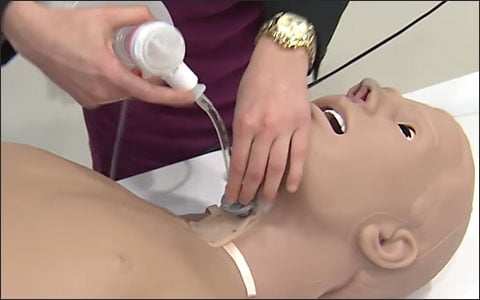In recent American military conflicts, 10 to 15 percent of the preventable battlefield deaths were due to airway obstructions or respiratory failure, which can lead to brain damage and death within minutes. Combat medics in the field who attempt the emergency neck-incision tactic — called a cricothyrotomy — experience a 33 percent failure rate. Even in a hospital setting, medical personnel experience a 15 percent failure rate.
With this in mind, a team of undergraduate students from the Center for Bioengineering Innovation and Design researched the issues and found that tools used for the emergency cricothyrotomy procedure failed to connect to the patient’s windpipe (trachea). The tools often became lodged just under the patient’s skin, or even bypassed the trachea and would instead strike the esophagus, which leads to the stomach rather than the lungs.
To help reduce preventable deaths on the battlefield or in other emergency situations, the design team crafted CricSpike — a hand-held cricothyrotomy-assist device kit. Their low-tech, low-cost solution improves both the speed and accuracy of the crike procedure.
The CricSpike kit features an intratracheal tip that is carefully designed to extend beyond the skin layers to the windpipe, but not far enough to reach the esophagus. The kit also includes a scalpel to make the neck incision, an endotracheal tube to channel air to the windpipe, and a bag valve mask that, when attached, aids technicians in pushing air through the tip or tube and into the wounded soldier’s lungs.
While the main pieces of the students’ kit require further refinement and testing, the early prototype shows great promise. It was awarded second prize in the student project category at the Innovation Lab Research Exhibition, presented at the Central Institute of Healthcare Engineering of Friedrich-Alexander University in Erlangen, Germany in July. In May, the team received a third-place prize in the 2016 Johns Hopkins Student Healthcare Design Competition, organized by the university’s CBID.
The students are now working to obtain a provisional patent covering the design of their CricSpike components.
Team member Qiuyin Ren of Westborough, Massachusetts, a rising senior, said she and the other team members intend to build a more polished prototype during the coming school year.
The student inventors — Antonio Spina, Himanshu Dashora, Michael Good, Jordan Kreger,
Ronak Mehta, Sondra Rahmeh, Qiuyin Ren, Travis Wallace, and Ryan Walter — hope a health care device maker will license their design and incorporate it into an improved cricothyrotomy kit for combat areas.

